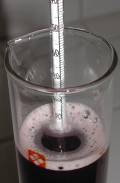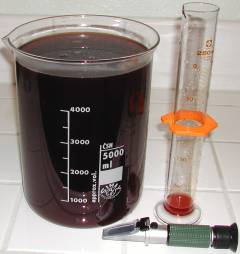I’m working on my first 6 gal. batch of muscadine wine. As a newbie I still have a lot to learn. I bought a spectrometer and realized it can be used before the fermentation process but will not be accurate as the alcohol develops.
I ran across an article about a fellow who believed that there should be a formula that would compensate for the presence and fluctuations of alcohol during fermentation. Anyone ever heard of this sort of calculation or tried it? It would seem an easier testing process if it is true. Here is a section of the article I read;
A refractometer with ATC (Auto Thermal Compensation) is unaffected by temperature, fermentation gases and only takes one to two drops to measure the sugar content of your must. However, it is effected by the different refractive index of ethanol. As the amount of alcohol increases the refractive index changes algorithmically. Unlike a Hydrometer the reading in a refractometer will never go to zero.
With a Refractometer you:
1.) Fill an eye dropper with a couple drops of juice
2.) Drip a drop or two on the refractometer lens
3.) Read the refractive index through the refractometer
In theory the ethanol effect is predictable and a formula should be able to compensate for it's refractive change.
To test the theory we fermented a Zinfandel kit and took measurements with both a professional refractometer and precision hydrometer using a formula from the CRC Handbook of Chemistry and Physics ("Concentrative Properties of Aqueous Solutions: Conversion Tables", 69th Edition Table 88 Sucrose). We then evaluated the correlation between the formula compensated refractometer readings against those from a precision hydrometer from start to finish of fermentation.
The formula tracked like rocket science. Over the 10 day fermentation we averaged less than 1% difference and that falls into the realm of user error.
Check our test results and download the file for your own use!
Our experiment results ( in .pdf)
Spread sheet to auto compensate for ethanol effect on a refractometer during fermentation (.xls Requires MSN Excel).
Formula for compensation of ethanol effect on refractometer: SG=1.001843-0.002318474(OB)-0.000007775(OB^2)-0.000000034(OB^3)+0.00574(AB) +0.00003344(AB^2)+0.000000086(AB^3)
SG = Specific Gravity, OB = Original Brix, AB = Actual Brix (Brix Readings During Fermentation)
Formula to convert from SG to Brix (for those who prefer Brix measurements):
Brix (Plato) = -676.67 + 1286.4*SG - 800.47*(SG^2) + 190.74*(SG^3)
Temperature compensation formula for hydrometers calibrated at 600F:
Correction = 1.313454 - 0.132674*F + 0.002057793*(F^2) - 0.000002627634*(F^3)
SG corrected = SG + (correction * 0.001)
Bubbles during fermentation attach to the hydrometer and skew your reading. Temperature adjustments are also necessary as most hydrometers are calibrated at 60 0F.

During our experiment we pulled 5750mL (1.5 Gallons) for the twice daily hydrometer readings. Compare to the 10ml of juice at right for a refractometer. Note that the small samples for the refractometer are not reintroduced back into the fermenter. Greatly reducing risk of contamination.

©2002-2006 The ValleyVintner. All Rights Reserved
I ran across an article about a fellow who believed that there should be a formula that would compensate for the presence and fluctuations of alcohol during fermentation. Anyone ever heard of this sort of calculation or tried it? It would seem an easier testing process if it is true. Here is a section of the article I read;
A refractometer with ATC (Auto Thermal Compensation) is unaffected by temperature, fermentation gases and only takes one to two drops to measure the sugar content of your must. However, it is effected by the different refractive index of ethanol. As the amount of alcohol increases the refractive index changes algorithmically. Unlike a Hydrometer the reading in a refractometer will never go to zero.
With a Refractometer you:
1.) Fill an eye dropper with a couple drops of juice
2.) Drip a drop or two on the refractometer lens
3.) Read the refractive index through the refractometer
In theory the ethanol effect is predictable and a formula should be able to compensate for it's refractive change.
To test the theory we fermented a Zinfandel kit and took measurements with both a professional refractometer and precision hydrometer using a formula from the CRC Handbook of Chemistry and Physics ("Concentrative Properties of Aqueous Solutions: Conversion Tables", 69th Edition Table 88 Sucrose). We then evaluated the correlation between the formula compensated refractometer readings against those from a precision hydrometer from start to finish of fermentation.
The formula tracked like rocket science. Over the 10 day fermentation we averaged less than 1% difference and that falls into the realm of user error.
Check our test results and download the file for your own use!
Our experiment results ( in .pdf)
Spread sheet to auto compensate for ethanol effect on a refractometer during fermentation (.xls Requires MSN Excel).
Formula for compensation of ethanol effect on refractometer: SG=1.001843-0.002318474(OB)-0.000007775(OB^2)-0.000000034(OB^3)+0.00574(AB) +0.00003344(AB^2)+0.000000086(AB^3)
SG = Specific Gravity, OB = Original Brix, AB = Actual Brix (Brix Readings During Fermentation)
Formula to convert from SG to Brix (for those who prefer Brix measurements):
Brix (Plato) = -676.67 + 1286.4*SG - 800.47*(SG^2) + 190.74*(SG^3)
Temperature compensation formula for hydrometers calibrated at 600F:
Correction = 1.313454 - 0.132674*F + 0.002057793*(F^2) - 0.000002627634*(F^3)
SG corrected = SG + (correction * 0.001)
Bubbles during fermentation attach to the hydrometer and skew your reading. Temperature adjustments are also necessary as most hydrometers are calibrated at 60 0F.

During our experiment we pulled 5750mL (1.5 Gallons) for the twice daily hydrometer readings. Compare to the 10ml of juice at right for a refractometer. Note that the small samples for the refractometer are not reintroduced back into the fermenter. Greatly reducing risk of contamination.

©2002-2006 The ValleyVintner. All Rights Reserved




